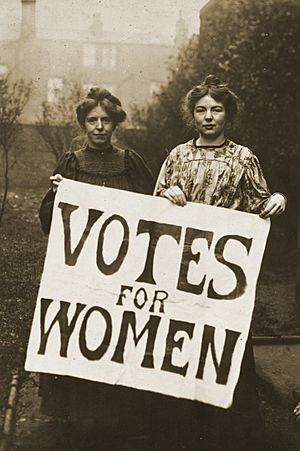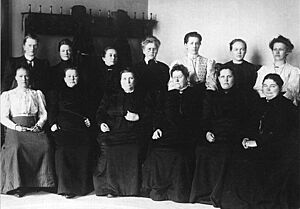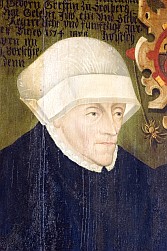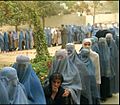Women's suffrage facts for kids
Women's suffrage is the right for women to vote in elections. It also means they can be chosen to hold a public office, like being a politician. This important right was usually won after many years of political campaigns and hard work. In some places, women gained the right to vote even before everyone else could vote (this is called universal suffrage). Before the late 1800s, women generally could not vote in any political election.
The modern idea of women voting began in France in the late 1700s. After the French Revolution, thinkers like Antoine Condorcet and activists like Olympe de Gouges argued that women should be allowed to vote in national elections.
Contents
Early Steps Towards Voting Rights
In the very first cases where women could vote, it was often only for certain women and in specific types of elections.
- In Sweden, some unmarried women who owned property could vote between 1718 and 1771.
- In New Jersey, unmarried women who owned property could vote from 1776 to 1807.
- In Sierra Leone in 1792, all heads of household could vote, and about one-third of these were women.
Countries Leading the Way
Several places that were once British colonies gave women the right to vote earlier than many other countries.
- On the Pitcairn Islands, female descendants of the Bounty mutineers could vote starting in 1838. They kept this right when they moved to Norfolk Island in 1856.
- In South Australia, women could vote in local elections from 1861.
- On the Isle of Man, women could vote in parliamentary elections from 1881.
New Zealand and Australia
In 1893, New Zealand became the first independent country to allow all adult women to vote in national elections. Soon after, in 1894, women in South Australia gained the same right. They were also the first to be able to run for seats in parliament.
European Progress
Many other countries soon followed, often after similar struggles.
- Women in several Western countries gained limited voting rights in the late 1800s. These included Sweden, Finland, and the United Kingdom.
- The Russian Empire was the first European country to introduce women's suffrage in 1906. It also elected the world's first female Members of Parliament in 1907. Finland was part of the Russian Empire at that time.
- Before World War I, women in Norway (1913) and Denmark (1915) also won the right to vote. Women in other Australian states gained this right too.
- In most other Western countries, women's suffrage came at the end of World War I.
Global Recognition
- Sri Lanka (then called Ceylon) recognized women's right to vote in 1931. In 1960, Sri Lanka elected the world's first female head of government, Sirimavo Bandaranaike.
- The United Nations officially recognized women's suffrage as a human right in 1979.
Related pages
Images for kids
-
The 1913 Woman Suffrage Procession in Washington, D.C., organized by Alice Paul.
-
South Australian suffragist Catherine Helen Spence ran for office in 1897. South Australia was the first place in the modern world to let women run for Parliament in 1895.
-
Women voting in Kabul during the first presidential election in Afghan history (October 2004).
-
Philippine President Manuel L. Quezon signing the Women's Suffrage Bill after a vote in 1937.
-
Jane Brigode, a Belgian suffragist, around 1910.
-
Wilhelmina Drucker, a Dutch pioneer for women's rights, in 1917.
-
Women voting during the Second Spanish Republic, November 5, 1933.
-
Swedish suffragist Signe Bergman, around 1910.
-
A British cartoon about why imprisoned suffragettes refused to eat.
-
This 1887 Melbourne Punch cartoon made fun of Australian women's rights. South Australian women gained the vote in 1895.
-
Edith Cowan (1861–1932) was the first woman elected to any Australian Parliament in 1921.
-
Program for the Woman Suffrage Procession, Washington, D.C., March 3, 1913.
-
The Silent Sentinels, women suffragists protesting in front of the White House around February 1917.
See also
 In Spanish: Sufragio femenino para niños
In Spanish: Sufragio femenino para niños



























